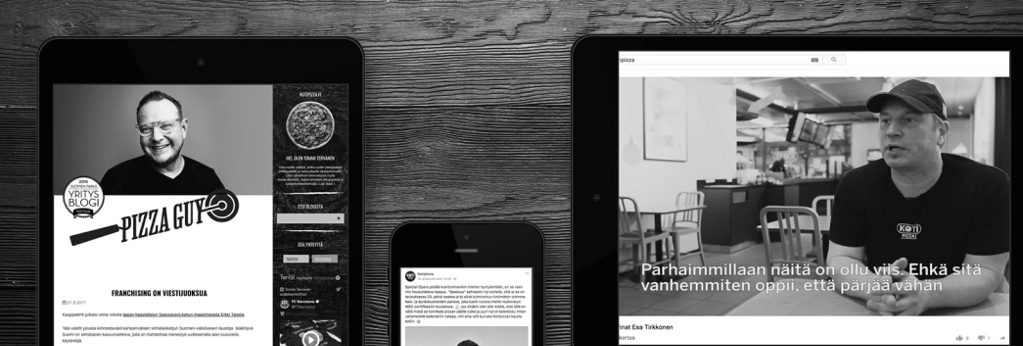Being customer-centric is vital
in an increasingly competitive and fast paced business environment. Most companies understand this and do their best to listen to – and understand – consumers and customers. But how do you get it to work all the way to tangible profitability at the point of action and transaction in your business?
Companies gather vast amounts of disparate data – purchase behaviour, survey results, not to mention all those digital footprints. No wonder big data has been the buzzword for quite some time now, and will continue to be so.
Frustrated by the ever increasing amount of data?
Massive databases are filled with potential knowledge about how to increase sales or how to develop and transform a business. The keyword here being “potential” and not so much “knowledge”.
The data in itself is quite useless unless you extract meaning from it and take appropriate action based on insights. The ongoing digitalization has exponentially increased the amount of data available to companies but making data-driven decisions is lagging behind. For companies, it is difficult to extract meaningful insights from the vast amount of data generated from multiple sources.
“Companies become more customer-centric by using their loyalty club as co-creation engines – fuelled by big data.”
Companies are frustrated because big data holds a lot of promise but simply gathering the data doesn’t lead to customer-centricity. Instead of starting with and focusing on the vast amounts of data at hand, business leaders must take a step back and evaluate what business issues they aim to solve.
The voice of the customer is a very strong voice
Yet it´s more of a sniper rifle than a shotgun. Customer opinions and behavior are totally dependent on context and is taken into account when designing a solution. Specifically, a solution that aims to inject the voice of the customer into company processes and operations is vital for success.
READ ALSO: Brand research: What is it & why is it important?
Let’s explore how a large grocery chain in the Nordics, improved their retail store operations and became more customer centric by utilizing a forgotten asset – their loyalty club. The company suffered declining market shares at a steady rate over several years. The average consumer’s view of the company was that it was badly managed (although good natured and considerate) grocery retailer compared to competitors. Consumer associations to the company brand included old fashioned, expensive and even uninspiring.
“The consumer insight department was staffed entirely with people from outside the organisation and had a fairly free role.”
How to unlock the power of the customers’ engagement
A number of re-organisation initiatives and re-engineering projects were undertaken over the years without changing the negative trend. In a drastic attempt to make the company more market oriented and customer-centric, they formed a new business unit. The new unit was set up as an independent entity within the company. It also included old functions such as brand, communication and CRM, as well as a few new functions. One such new team was the consumer insight department. The department was staffed entirely with people from outside the organisation and had a fairly free role.
The new team began exploring the consumer’s perspective on the company and what assets the company had for insight generation. They found two things:
- The amount of data the company had about customers and transactions was endless and despite the downward trend,
- the company had not lost the engagement of their core customers.
The company asked Nepa – the Consumer Science company – to help them try to harness those two assets. The overall objective given to Nepa was clear: unlock the power of the customers’ engagement and their data in order to involve them in the re-design of the company into a modern retailer.
Nepa did not make the mistake of focusing on data rather than key business issues. Instead, Nepa and the company agreed that the first business problem was to improve the store operations.
READ ALSO: Benefits of Path to Purchase analysis
The first 3 vital steps
As the consumers found the company somewhat old fashioned and uninspiring we decided to:
- Get more actionable insights from customers about possible improvements in the store environments and operations.
- Gather relevant data and make it actionable for over 650 stores.
- Deploy its solution for trigger based research by utilizing the Nepa Consumer Science platform®.
As previously mentioned, the company had an amazing asset in the engagement among their core customers. And they had a lot of them – The company’s loyalty club included more than 3 million members at the time. In order to make these numbers more manageable, Nepa invited the company’s members to join a smaller co-creation engine inside the club. Members were quite eager to join and soon the number of members in the co-creation engine was over 40 000.
Analyzing and visualizing details are key factors
The key feature of the Nepa Consumer Science platform® is having one customer-ID on each panellist – allowing attribution of any type of data to each individual. This allows Nepa to combine behavioral big data with attitudinal data – enabling trigger-based research using big data.
Every time a member of the co-creation engine shopped at a company store, personalized research can be triggered. The research is based on store visits and buying behavior. The company didn’t have to ask if a customer went to the bread section of a specific store in for example Stockholm. Before asking any questions , the customers already knew exactly what baked goods had been bought, when and where.
A continuous stream of development opportunities
To date the co-creation engine has:
- Combined 2 billion lines of sales data with over 8 million points of direct customer feedback.
- Packaged the data into over 2500 automated reports during a year.
- Delivered the reports to over 600 stores each quarter.
“The introduction of the Nepa Consumer Science platform® tailored the feedback to each retail outlet.”
The format and delivery of these reports is key. It keeps insights actionable and not overwhelming the receiver with information and data.
Prior to the implantation of the Nepa Consumer Science platform® the company had general reports available on a regional level – regional managers where responsible for disseminating insights to individual store owners. The feedback wasn’t tailored to each retail outlet which was the problem. The introduction of the Nepa Consumer Science platform® changed this. A short 3-page report detailing key improvement areas in an importance/performance matrix, how the store was faring per department, and performance compared to local competitors and other company stores provided store managers with a clear guide as to what was working in-store and what wasn’t.
The financial impact – catching the eyes of store managers
Coupling sales data to the trigger-based research, the findings and recommended actions was translated into financial impact. For example, a certain level of satisfaction within the produce section is assigned an economic value based on the performance of the company’s stores. We can estimate the economic value of implementing changes suggested by customers and increasing the particular store’s satisfaction within that department.
This meant a greatly increased interest for the reports among store managers. The reports are hanging in the staff rooms of the company stores all over the country. This enables a localized data driven approach to store operations.
READ ALSO: Brand tracking is key to increase brand awareness
The voice of the customer is helping redesign the company
So far, a little over 180 000 customers have engaged in the initiative and have provided store managers with almost 250 000 suggestions, comments and ideas. Most of them are very specific and valuable to the local manager; some of them being complaints and comments regarding price. The average customer experience with the company has improved markedly since the start of the initiative.
In addition to evaluating store operations on a continuous basis – the co-creation engine also allows for extremely cost-effective ad-hoc research. Even though the company has very limited resources in the insight department (only 5 FTEs), they still manage to turn around over 120 ad hoc research projects per year.
The co-creation engine has been vital in redesigning the company and improving their operations. The company has harnessed the power of their engaged customers and the co-creation engine in Nepa Consumer Science platform® enjoys an extremely high response rate, over 50% with no signs of dropping.
“The company became much more customer-centric in their local operations by tapping an incredibly valuable asset – their own loyalty club.”
Beyond CRM – business growth triggered by consumers
To further leverage this quick feedback loop, Nepa built a digital live feedback tool for the company’s headquarters. Digital screens display a map of the country and populate it with customer feedback from different stores across the country – in real time. This is extremely valued by management who are already using the KPIs from the Nepa Consumer Science platform® as some of the main governing tools for the entire company.
The company became much more customer-centric in their local operations by tapping an incredibly valuable asset – their own loyalty club. Many companies today are underutilizing this asset and merely engaging in traditional CRM activities. It’s time for these companies to stop being confused by large data sets, look beyond CRM as a solution to customer-centricity and couple behavioral and survey data to build co-creation engines.
We help businesses to thrive with customer-centricity by utilizing the power of continuous consumer insights. There is no end to what you can achieve with real-time consumer insights, customer feedback and footprints. It changes the way your business engage with customers.
Please do get in touch if you’d like to find out more.
Lindsay Cowan
Managing Director of Nepa UK





